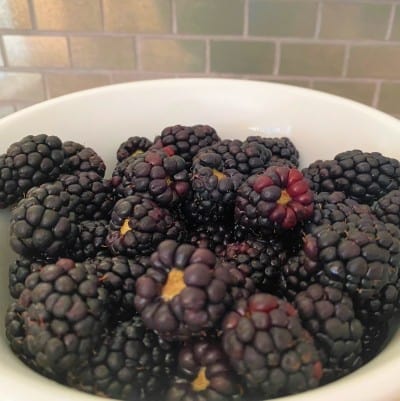This long-simmered vegetable broth infused with ginger, garlic, star anise, and a medley of nutritious veggies is nourishing for body and soul. It will fill your kitchen with wonderful, invigorating smells.
Although the pleasantly sweet homemade broth is a healing and hydrating drink on its own, it’s also a terrific base for a variety of vegan and vegetarian soups and grain- or legume-based dishes.

Would you like to save this recipe or article?
You won't get spam from me, I promise!
Say goodbye to high-sodium store-bought versions with this easy recipe for low sodium veggie broth with many health-boosting goodies!
I earn from qualifying purchases at no extra cost to you as part of the Amazon Affiliate program.
Table of contents
Ingredients

- Olive or canola oil
- Sweet onions
- Carrots
- Celery
- Shallots
- Garlic
- Ginger
- Parsley stems
- Bay leaf
- Star anise pod
- Black peppercorns
- Kosher salt (optional)
- Water
Olive or canola oil: If using olive oil, choose one that is refined and light-tasting. No need for your best extra virgin in this recipe.
🧅Sweet onions: Look for large, yellow sweet onions like Vidalias or Walla Wallas. Other onions will work in this recipe, but these have the sweetest flavor.
🥕Carrots: An earthy sweet counterpoint to the onion and other alliums, there is no need to peel if your carrots are not too scarred. Just wash them well.
Celery: This is such an important veggie, particularly for low sodium broth. It has a naturally salty taste and helps the broth stay fresh longer.
Shallots: They enrich and deepen the oniony tastes in the broth.
🧄Garlic: This allium is so important for fighting a variety of chronic diseases and for maximum flavor. No need to chop the cloves. Just smash and bruise to release flavor and healthful compounds, but please remove any bitter green sprouts.
🫚Ginger root: The invigorating and immunity-boosting tuber makes for a delicious, sippable broth.
🌿Parsley stems: These powerful green herb stems add a robust, fortifying note to the veggie stock.
Bay leaf: Another spice that ups flavor and enhances gut health.
Star anise: This sweet spice smells terrific!
Black peppercorns: Here again, these boost the taste and help with absorption of the vitamins and minerals in the broth.
Kosher salt: I like to add a very small amount to bring out the umami qualities of the veggies. It is not necessary, and can always be added later when you drink or cook with the broth.
Full recipe with amounts and detailed instructions is below in the recipe card at the end of the post.
How to Make the Best Broth
👐🏼Always begin with a good hand washing, lathering with soap and rinsing for 20 seconds (about the time it takes to sing Happy Birthday).
1️⃣ Prepare the veggies by removing the peels from the onions and shallots. Remove carrot peels if they are very dirty or scarred. You can use a spoon to scrape off the ginger peel.
Smash an entire head of garlic and remove the cloves. Cut the cloves in half to remove any green sprouts.
Clean all veggies, washing the onions, carrots, celery, shallots, ginger, and parsley stems.
Chop onions and shallot roughly. Slice the carrots and ginger into largish coins. Tear the parsley stems in half.
2️⃣ Heat a small amount of olive or canola oil in a large stock pot over medium heat. Add onions, and then carrots, celery, and shallots. Cook for two to five minutes, stirring occasionally.


Add the garlic, and stir again, and after a few seconds, add the parsley stems, bay leaf, star anise pod, peppercorns, and salt. Combine with the vegetables, warming the spices for a few seconds.


3️⃣ Pour the water over the vegetables, stir, and bring to a boil. Skim foam off the top or break it up so that it disappears under the surface.


4️⃣ Lower heat and simmer for an hour to an hour and a half.
5️⃣ Strain immediately. (It’s best to do this in a large sink in case of any spillage.)

6️⃣ Let the broth cool and then refrigerate or freeze for later use.

Storage Thoughts
If you plan on using the broth within about three days, simply keep it refrigerated. It makes a lovely drink, warm or cold.
Freeze for up to a year.
Ice cube or Souper Cube containers are convenient for storage. Once the broth has frozen into cubes, pop them out and place them in a freezer bag.
You can also use a funnel to pour the broth into quart-size jars or freezer bags that you can stand inside a jar.
🔪Preparation tips
Although the vegetables only need a rough chop, don’t leave huge chunks. You’ll get more flavor from large or medium-size pieces.
Also, larger pieces will not become total mush after simmering. You can save these softish veggies and puree to make a lovely spring vegetable soup similar to my basic Carrot Celery Soup.
If pressed for time, skip the sauté step of the recipe and simply pour the water over the vegetables. The upside of this is that you have a broth that is practically fat-free. The downside is that the flavor is less robust.
Since vegetable stocks have a lighter taste than animal-based stocks, the sauté step yields tastier results.
➕Additions and variations
If ginger is not your favorite, just leave it out and the broth will still taste fine.
You may want to change the spices also. Omit the star anise pod, and throw in some fresh or dried thyme.

A few leeks would not hurt either. Mushrooms add a satisfying heartiness to the broth.
FAQ
Vegetables to avoid include cruciferous veggies like broccoli, cauliflower, and Brussels sprouts. I prefer to omit starchy veggies like potatoes, which will make the broth cloudy.
Yes! I often do this and have a Vegetable Scraps Broth recipe that uses the Instant Pot to speed the process.
I keep a gallon bag of trimmings that are mainly onions skins, a few parsley stems, and trimmings from mushrooms, carrots, and celery in the freezer. When it is full, I’m ready to make broth/stock.
Broth is usually lighter and more sippable than stock because it’s seasoned with salt and pepper. Stock is also usually made from bones, but since vegetables don’t have bones, it’s difficult to know whether to call it broth or stock.
Filtering water removes impurities from water, such as lead or other contaminants. So, it can make your broth healthier and improve the taste.
⚕️Health Benefits
This vegetable stock/broth is full of anti-inflammatory goodness from the ginger, garlic, and onions. It may have benefits for the immune system.
Ginger contains several anti-inflammatory phenolic compounds: Gingerols, paradols, and zingerone. Ginger can also provide an energy boost.

Alliums in this recipe
Onions are a wonderful source of quercetin, another anti-inflammatory phenolic compound, and garlic is celebrated for its ability to fight many chronic diseases, such as heart disease, high blood pressure, and perhaps cancer.
Carrot power
Carrots, of course, are full of antioxidant carotene pigments, such as beta carotene. These may be preventive when it comes to diseases like cancer, perhaps particularly for cancers in the mouth and lungs.
Of course, carrots are also linked to better vision. 👀
In addition to increasing the flavor of almost any soup or broth, celery also boasts anti-inflammatory health benefits plus vitamins and minerals galore.
Digestive benefits
Ginger, in particular, may improve digestion. Bay leaf is a spice used in traditional medicine to improve digestive distress such as bloating.
Celery, onion and garlic, as prebiotics, may also help digestion, but this is primarily if they are eaten.
Since they are strained out of the broth, they will not have a prebiotic effect. However, the broth will contain many of their anti-inflammatory compounds, vitamins, and minerals.
Of course, the flip side of prebiotics is that many are FODMAPs, and contain fructooligosaccharide sugars that can irritate sensitive intestinal cells in some individuals.
- Hydration help: With a bevy of electrolytes and minerals, using the broth in soups and as a simple, nourishing beverage is terrific for optimal fluid intake.
- Blood pressure: Because it contains very little sodium, you can use this broth in your cookery with little fear that it will raise your blood pressure. Of course, the same can not be said for store-bought stocks and broths.
Souper Uses for Vegetable Broth
As mentioned, it is a soothing and hydrating beverage when enjoyed warm or cold.
Of course, it is ideal as a base for vegetarian and vegan soups. Try it in this simple velvety Carrot Celery Soup.
Other vegetarian/vegan soups that would taste nice with this broth are Creamy Pumpkin Tomato Soup with Apples and hearty Mushroom Barley Soup, which comes together quickly in the Instant Pot.
The gingery broth would also pair well with the spices in Oven Baked Turmeric Rice. This hearty pilaf makes a terrific dinner with a salad and bread on the side!
Try it with other grains like farro or with quick-cooking legumes such as red lentils.
Other Soothing Sips You Might Like….
If ginger is a favorite, take a look this amazing Ginger Milk Tea. It’s the ultimate afternoon pick-me-up!
Bay Leaf Tea is a mild cuppa that can help with stomach ache and bloating.

Sweet Ginger Veggie Stock with Carrots and Onions
Equipment
- Stock pot
- Peeler or grater
Ingredients
- 2 large onions Use three if your onions are small to medium.
- 1 Tablespoon olive oil
- 4 large carrots, roughly chopped, and peeled, if necessary
- 3 celery stalks, roughly chopped
- 2 small shallots, roughly chopped, green inner sprout removed
- 1 head garlic, smashed and peeled, green inner sprouts removed
- ½ bunch parsley stems
- 1 bay leaf
- 1 star anise pod
- ¼ teaspoon salt, kosher, add more if desired
- 6 to 8 black peppercorns
- 3 pints water, filtered, if desired
Instructions
- Wash hands, lathering with soap and rinsing with water for 20 seconds.
- Prep veggies. Wash all veggies after removing skins or peeling as necessary. Roughly chop, removing any green inner sprouts from onions, shallots, and garlic as necessary.There is no need to chop garlic cloves if they are smashed or slightly bruised; however, the green inner sprouts taste bitter, so it's best to remove them.
- Heat oil in a large stock pot. Add onion and the other veggies, cooking over medium-high heat for about five minutes.
- Add ginger, parsley stems, star anise, salt, and peppercorns, and cook, stirring, for another minute.
- Carefully pour in a quart of stock. Stir and scrape up any browned bits of vegetable on the bottom of the pot. Add the rest of the water and bring to a boil. Skim off or break up any foam that accumulates on top.
- Reduce heat to a simmer and cook, uncovered, for an hour to an hour and a half.
- Strain immediately. (It's best to do this in your kitchen sink in case of spillage.)
- Pour stock/broth into containers for storage. Enjoy as a healing beverage; use it to make vegan or vegetable soups and as the liquid when cooking grains.Freeze any that will not be used within a few days.
Notes
Nutrition
Copyright © 2024 Jani H. Leuschel






Leave a Reply